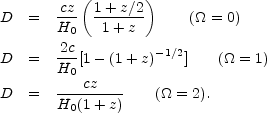


The flux density S as a function of frequency
 and the angular
size
and the angular
size  of a radio
source are the observables directly relevant to most cosmological
problems. They
are related to the intrinsic source luminosity L and projected linear
size d as described below.
of a radio
source are the observables directly relevant to most cosmological
problems. They
are related to the intrinsic source luminosity L and projected linear
size d as described below.
Consider an isotropic source at redshift z with spectral luminosity
L at frequency
 (measured in the source
frame). Its spectral flux density S measured at the same frequency
(measured in the source
frame). Its spectral flux density S measured at the same frequency
 (in the observer's frame) will be
(in the observer's frame) will be
 |
(15.1) |
where A is the area of the sphere centered on the source and
containing the observer and

 - ln(S /
S0) / ln(
- ln(S /
S0) / ln( /
/  0) is the two-point
spectral index between the frequencies
0) is the two-point
spectral index between the frequencies
 and
and
 0 =
0 =
 / (1 + z) in the
observer's frame. (Note that the negative sign convention
for
/ (1 + z) in the
observer's frame. (Note that the negative sign convention
for  is used throughout
this chapter.) The
(1 + z)1+
is used throughout
this chapter.) The
(1 + z)1+ term expresses the special
relativistic Doppler correction; the geometry and expansion dynamics of the
universe appear only in A. An "effective distance" D
(Longair 1978)
can be defined by A
term expresses the special
relativistic Doppler correction; the geometry and expansion dynamics of the
universe appear only in A. An "effective distance" D
(Longair 1978)
can be defined by A  4
4 D2. Since
the area of the sphere centered on the observer and containing
a source at redshift z is always
A / (1 + z)2, the relation between
(projected) linear size d and measured angular size
D2. Since
the area of the sphere centered on the observer and containing
a source at redshift z is always
A / (1 + z)2, the relation between
(projected) linear size d and measured angular size
 is
is
 |
(15.2) |
The "angular size" distance is defined by
D
 d /
d /  = D /
(1 + z). The "bolometric luminosity distance"
Dbol defined by
Sbol = Lbol /
(4
= D /
(1 + z). The "bolometric luminosity distance"
Dbol defined by
Sbol = Lbol /
(4 Dbol2) is given by
Dbol = D(1 + z).
Dbol2) is given by
Dbol = D(1 + z).
In Friedmann models (cosmological constant
 = 0) with zero
pressure, density parameter
= 0) with zero
pressure, density parameter
 =
2q0, and current Hubble parameter H0
the effective distance is traditionally given
(Mattig 1958) as
=
2q0, and current Hubble parameter H0
the effective distance is traditionally given
(Mattig 1958) as
 |
(15.3) |
However, this formula is numerically unstable for small
 z, the
transformation (based on
Terrell 1977)
z, the
transformation (based on
Terrell 1977)
 |
(15.4) |
is better for numerical calculations. For particular values of
 , D reduces
to the simpler forms:
, D reduces
to the simpler forms:
 |
(15.5a)
|
To describe the distributions of sources in space and time, we also need
the comoving volume dV of the spherical shell extending from
z to z + dz. It is
dV = 4 D2 dr, where the comoving radial coordinate
element is dr = - (1 + z)c dt. In a Friedmann
universe the expansion rate is
D2 dr, where the comoving radial coordinate
element is dr = - (1 + z)c dt. In a Friedmann
universe the expansion rate is
 |
(15.6) |
so
 |
(15.7) |